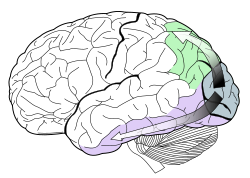
来自北京大学心理学系,伦敦大学学院,中科院生物物理研究所的研究人员证明了人类的初级视觉皮层可以在视觉信息加工的非常早期阶段生成视觉显著图,用以引导空间选择性注意的分布。这一发现挑战了传统注意理论,相关成果公布在神经科学著名期刊《神经元》(Neuron)杂志上。
文章的通讯作者是北京大学机器感知与智能教育部重点实验室方方教授,第一作者是心理学系博士生张喜淋。研究合作者包括伦敦大学学院(University College London)李兆平教授和中科院生物物理所周天罡副研究员。
对注意机制的研究可能是认知神经科学领域中最受关注的科学问题。注意是指心理资源被有选择性的分配给某些认知加工过程,使得这些认知过程对信息的加工更加快速准确。注意对于协调各种认知加工过程非常重要。人类每一时刻都接受到大量的外界信息,处于被“信息轰炸”的状态中。我们有限的心理资源和神经资源不可能同时处理这么多的信息,只能选择性的处理具有高优先性的信息而忽视低优先性的信息,注意的作用正是体现于此。
在这篇文章中,研究人员结合心理物理学、功能性磁共振成像(fMRI)、高密度脑事件相关电位(ERPs)和计算模型证明了人类的初级视觉皮层可以在视觉信息加工的非常早期阶段(72-74毫秒)生成视觉显著图,用以引导空间选择性注意的分布。该领域中的主流理论是额叶-顶叶网络负责注意的生成和调节,但以往研究混淆了自下而上和自上而下两种注意过程,该研究通过引入对意识水平的操作来分离这两种过程,证明了自下而上的注意及其分布(即视觉显著图)完全可以由初级视觉皮层的活动预测。
这些发现挑战了传统注意理论,促使我们重新思考负责注意调控的脑神经网络。这个研究对机器感知领域也有重要意义,它为复杂场景中视觉信息加工算法,提供了来自认知神经科学的新的理论依据和约束。

Neural Activities in V1 Create a Bottom-Up Saliency Map
Xilin Zhang, Li Zhaoping, Tiangang Zhou, Fang Fang
The bottom-up contribution to the allocation of exogenous attention is a saliency map, whose neural substrate is hard to identify because of possible contamination by top-down signals. We obviated this possibility using stimuli that observers could not perceive, but that nevertheless, through orientation contrast between foreground and background regions, attracted attention to improve a localized visual discrimination. When orientation contrast increased, so did the degree of attraction, and two physiological measures: the amplitude of the earliest (C1) component of the ERP, which is associated with primary visual cortex, and fMRI BOLD signals in areas V1–V4 (but not the intraparietal sulcus). Significantly, across observers, the degree of attraction correlated with the C1 amplitude and just the V1 BOLD signal. These findings strongly support the proposal that a bottom-up saliency map is created in V1, challenging the dominant view that the saliency map is generated in the parietal cortex.
文献链接:https://www.cell.com/neuron/abstract/S0896-6273(11)00999-8








